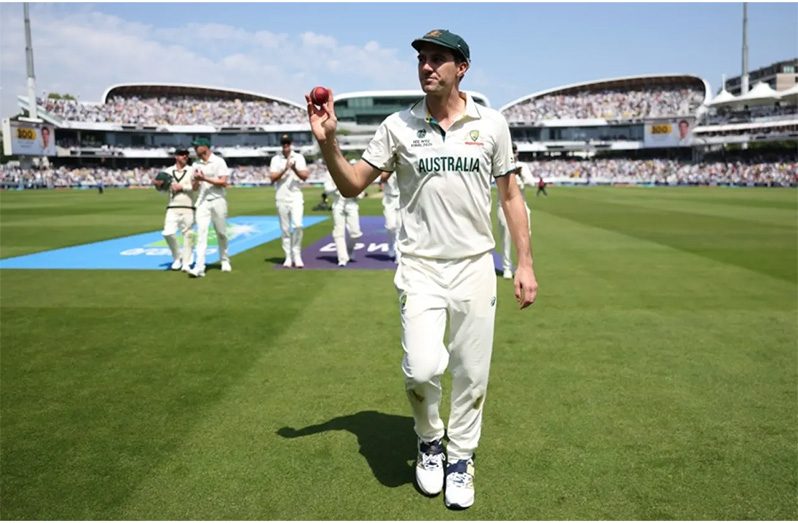(ESPNCRICINFO) – For two hours in the middle of day two, Australia had one hand on the WTC mace after taking a 74-run first-innings lead at Lord’s. For the next two, South Africa did their utmost to prise their fingers from it, and for the one after that, Alex Carey and Mitchell Starc fought them off with a a 61-run eighth wicket partnership. As things stand, Australia still have a few fingers on the mace after a gripping day of Test cricket.
It was, once again, a day for bowlers. Fourteen wickets fell on day two, the same number as the first day, for a total of 28 wickets in six sessions.
Pat Cummins stole the early headlines when he became the first visiting captain to take a five-for at Lord’s and then went on to pluck his 300th Test wicket. Then it was over to Kagiso Rabada and Marco Jansen who had Australia 44 for 3 before Lungi Ngidi, back in the Test side after 10 months and coming off a poor first innings, redeemed himself with three wickets in a nine-over spell that broke Australia open.
Where things stand at the end of the day is that South Africa will already have to pull off the fourth-highest successful chase at Lord’s, and do it against Australia’s unrelenting attack. That means it’s probably still advantage Australia after a breathless seven-and-half-hours in a final that has hit fast-forward.
South Africa resumed on 43 for 4, 169 runs behind Australia’s 212 and on a go-slow. Temba Bavuma had laboured his way to 3 off 37 overnight as South Africa’s innings ground to a halt, but he showed more initiative on the second morning. He struck two glorious lofted drives in Mitchell Starc’s second over of the day and looked to be finding his touch. Bavuma was on 17 before he was given out lbw off a Josh Hazlewood delivery that nipped in and struck his back pad, and he reluctantly reviewed. To everyone’s disbelief including Bavuma’s, Snicko showed an inside-edge. Bavuma went on to drive Hazelwood and Starc over the covers and pull Pat Cummins into the stands for six in what looked like an increasingly authoritative stay at the crease.
His partnership with David Bedingham grew to 64 and it took a moment of magic in the field to separate them. Bavuma drove Cummins in the air and to the right of Marnus Labuschagne, who dived full length a cover and pouched it with both hands.
Bavuma’s dismissal sent South Africa back into their shells. Bedingham and Kyle Verreynne scored 17 nervy runs in the next 52 balls and both looked vulnerable. Bedingham was drawn into a false stroke by Hazlewood and Verreynne was on 1 when he edged Beau Webster just short of Smith at second slip. But the moment of controversy came when Bedingham edged Webster onto the flap of his pad. Alex Carey moved towards him in an attempt to take a catch and the ball bobbled into and then out of Bedingham’s pad flap. At that moment, Bedingham reached for the ball and dropped it close to his foot. Khawaja and Smith began appealing for obstructing the field, and there was some excitement before it was decided the ball was dead. Bedingham responded by hitting the next ball, a half-volley, for four and South Africa went to lunch on 121 for 5, 91 runs behind.
More drama ensued after the break when Cummins hit Verreynne on the pad as he shuffled across, and the ball deflected to fine leg. Verreynne attempted a run, Cummins turned to appeal, and the pair collided, by which point a throw had come in and there was also the chance of a run-out. Cummins asked for a review on the lbw and replays suggested the ball would have gone on to hit leg stump. Three balls later, Jansen handed Cummins a simple return catch, and at 126 for 7 South Africa were in disarray.
Cummins completed his five-for when he had Bedingham caught behind off a thin edge three overs later and then got his 300th when Rabada nailed a pull to Webster at deep square. Cummins finished with 6 for 28 in a final analysis that included six maiden overs out of 18.1 and barely a bad ball. Crucially, he gave Australia an important lead that could still have a decisive say on this game.
The same can be said of South Africa’s collapse. They lost 5 for 12 in 35 balls; Australia had lost 5 for 20 in the same time on day one.



.jpg)








